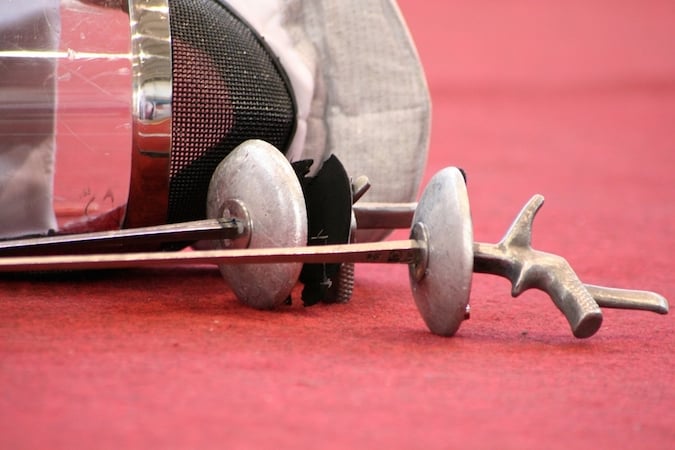Fencing equipment

Image credit: Shutterstock.com
Fencing requires numerous equipment and gear that are regulated by the Federation Internationale d’Escrimes (FIE). The following is a list of the most common equipment that you will need in order to fence safely.
Weapons
There are three types of weapons that a fencer can choose from - the foil, saber and epee. The foil is a light weapon that mainly targets the torso, and features a small hand guard to protect the hand from stabs. The epee is similar to the foil, but is much heavier in comparison. Additionally, the handguard of the epee covers the entire hand. Lastly, the saber is also a light weapon, with the hand guard extending from the base of the hilt to the pommel.
Clothing
Fencers have to wear the full set of protective clothing when in a match. This includes a form-fitting jacket with a strap that goes between the legs, and is made of tough cotton or nylon, sometimes with Kevlar on the top layer. A plastron, which is an underarm protector, goes underneath the jacket in order to provide extra protection. A glove is also worn on the weapon arm in order to prevent injuries from the blade going under the sleeves of the jacket. The glove also provides better grip for the fencer.
Breeches are also worn, which are short trousers that end below the knee. Fencers also have to wear knee-high or thigh-high socks alongside the breeches, as well as flat-soled shoes. A mask with bib is also required of all fencers, in order to protect the face and neck from any injuries. The FIE requires the mask to be able to withstand 25 kilograms of weight on the mesh part of the mask, and 1600 Newtons of impact on the bib.
In foil and saber fencing, lamé is also worn. Lamé is an electronically conductive material that helps in determining which touches are inside of the target area. In foil fencing, the lamé is sleeveless, while saber fencing sees sleeves on the lamé.
Additionally, female fencers are also mandated to wear plastic chest protectors. Male fencers can also opt to wear these protectors, although it is not required of them. In most cases, the entire outfit is white for fencers, and black for instructors, as it makes it easier to observe where the touches occurred since weapons used were covered in dye or soot. However, as electronic scoring has become more popular, the colours of uniforms have been relaxed, but white is still largely the preferred colour.
To receive the latest updates on the happenings in the Singapore sports scene, or to find out more about some of the latest programmes on offer at ActiveSG, like our Facebook page here.





![ActiveSG Academies and Clubs Logo (Solid Colour)[8647]](https://www.activesgcircle.gov.sg/hs-fs/hubfs/ActiveSG%20Circle%202023Theme/images/ActiveSG%20Academies%20and%20Clubs%20Logo%20(Solid%20Colour)%5B8647%5D.png?width=150&height=65&name=ActiveSG%20Academies%20and%20Clubs%20Logo%20(Solid%20Colour)%5B8647%5D.png)



-01.png?width=200&height=141&name=Team%20Singapore%20Logo%20(Red)-01.png)



